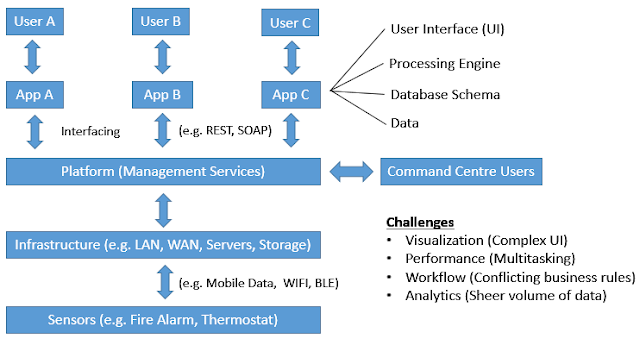Introduction (What is IoT?)
• Inclusion of a microchip into devices to enable connection to a network.
• Allows such devices to collect and exchange data over the network.
• Objective is to achieve little or no human intervention.
• Devices are uniquely identified by Internet Protocol version 6 (IP v6) which is able to scale large number of devices.
Examples of Technologies that enable IoT
1. Ethernet – General purpose networking standard for fibre network links.
2. HomePlug – Networking standard for home or building’s power lines.
3. Bluetooth – Enables mobile devices in close proximity to communicate with one another.
4. Near Field Communication (NFC) – Incorporated into smartphones for access to public transportation.
Examples of Applications of IoT
1. Consumer Appliances
• Enables the owner to control the appliances without being in close proximity (e.g. turning on the air-conditioner to cool the room before reaching home).
2. Medical & Healthcare
• Enables remote health monitoring & emergency notification (e.g. pacemakers having the ability to inform the hospital automatically in the event of cardiac arrest).
3. Transportation
• Enables communications, control, and information processing across transportation systems (e.g. smart parking system that guides the vehicle driver to the nearest available parking lot).
4. Environmental Monitoring
• Assist in environmental protection through monitoring.
• Ideal for mobility and monitoring large geographic areas (e.g. earthquake & tsunami warning systems) due to wireless sensing.
Challenges of IoT
1. Precision
• Inaccurate location or timing causes failure and sometimes danger (e.g. in a vehicle-to-vehicle communication system, inaccurate location causes failure to apply the brakes in time to prevent collision).
2. Adaptability & Scalability
• Must be adaptable and scalable through software or added functionality that integrates with the overall solution (e.g. the air-conditioner having the capability to be turned on/off remotely, it should be able to integrate with another application that turns on/off the air-conditioner and other devices at pre-determined timings).
3. Security
• Connected to network increases the risk of unauthorised access and attacks (e.g. hacking into the vehicle communication system to disable the brakes as a form of sabotage).
4. Maintenance & Updates
• Systems need to be continually modified or updated to meet changing requirements (e.g. a mobile app for communication need to be updated to include a new feature to enable video chatting).
Artificial Intelligence
• IoT produces sheer volume of data which must be analysed for continuous improvement to the business process.
• Applying artificial intelligence is therefore necessary to improve the speed and accuracy of analysing IoT data.
• Examples:
- Robotic vacuum cleaner that remembers the home layout and determine the most efficient movement to clean the house.
- Smart thermostat solution that controls energy usage based on the regular temperature preferences and work schedules of its users.
- Self-driving vehicle that determines the most ideal route to the destination based on map and traffic conditions.
IoT Architecture
There are 4 major layers in the IoT architecture namely:
- Sensors - Devices that collect and send data.
- Infrastructure - Facilities that support storage and connectivity.
- Platform - An application that integrates the various applications (i,e, system of systems).
- Applications - Suite of applications that support a particular area (e.g. there are applications such as Fire Alarm System, Temperature Control System and Access Control System for Building Management).
The key challenges faced by integrating systems include:
- Visualization - Due to the large number of functionalities that the Platform layer needs to support, presenting the user interface can be a major challenge. Nevertheless, the user interface must be intuitive in order for the system to be successful.
- Performance - As multitasking (many background processes running concurrently) is highly possible in order to support the large number of functionalities, performance would be a possible issue. The infrastructure must be powerful and application codes must be written effectively to improve performance.
- Workflow - When different applications are integrated together, there may be business rules that conflict with one another. A good example is the Temperature Control System that switches on the air-conditioner when the room temperature is above 27 degree Celsius. However, when the room temperature is above 50 degree Celsius, the Fire Alarm System would be activated as there is a high possibly of a fire outbreak. In this case, the Temperature Control System would also switch on the air-conditioner as the room temperature is above 27 degree Celsius. Hence, it may be necessary to adjust the business rules accordingly.
- Analytic - A sheer volume of data would be produced when applications are integrated together. Applying artificial intelligence is therefore necessary to improve the speed and accuracy of analysing these data.
1. Internet of things (Wikipedia)
https://en.wikipedia.org/wiki/Internet_of_things
2. 5 Key Challenges Facing the Industrial Internet of Things
http://www.cio.com/article/2872574/it-industry/5-key-challenges-facing-the-industrial-internet-of-things.html
3. Artificial Intelligence Plus the Internet of Things (IoT) – 3 Examples Worth Learning From
http://techemergence.com/artificial-intelligence-plus-the-internet-of-things-iot-3-examples-worth-learning-from/

No comments:
Post a Comment